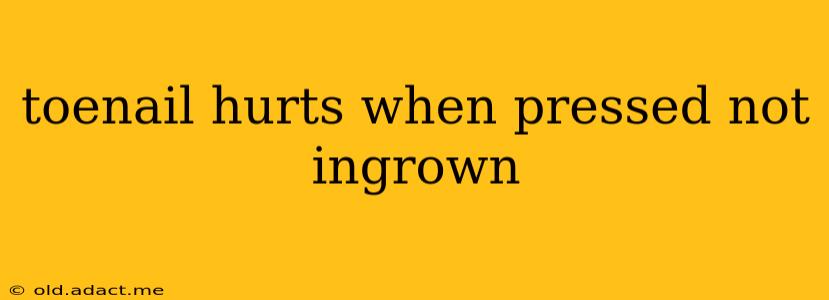A painful toenail that hurts when pressed, but isn't ingrown, can be surprisingly common and stem from various underlying issues. While an ingrown toenail is a frequent culprit for toenail pain, several other conditions can cause similar discomfort. This comprehensive guide explores potential causes, effective home remedies, and when professional medical attention is necessary. Understanding the root cause is crucial for effective treatment.
What Could Be Causing My Toenail Pain?
Several factors can lead to toenail pain when pressure is applied, even without the presence of an ingrown nail. Let's explore some possibilities:
1. Toenail Bruise (Subungual Hematoma):
This is a common cause of toenail pain. A direct impact or trauma to the toenail can cause blood to collect beneath the nail plate, forming a hematoma. This buildup of blood puts pressure on the sensitive nerve endings under the nail, leading to significant pain when pressure is applied. The toenail may appear discolored, often with a dark purple or black area under the nail.
2. Fungal Infection (Onychomycosis):
Fungal infections of the toenail can thicken and distort the nail, making it more sensitive to pressure. The infection can also cause inflammation and pain around the nail bed. Symptoms of a fungal infection might include yellowing, thickening, crumbling, and a foul odor.
3. Trauma or Injury (Not Necessarily Bruising):
Even minor trauma, like repeatedly stubbing your toe or wearing ill-fitting shoes, can cause inflammation and pain in the toenail area. This can make the nail more sensitive to pressure without necessarily resulting in a visible bruise.
4. Psoriasis:
Psoriatic arthritis can affect the nails, leading to pitting, discoloration, and thickening. This can also cause pain and sensitivity to pressure. Psoriasis often manifests in other areas of the body, such as the skin and joints.
5. Underlying Medical Conditions:
In rare cases, toenail pain can be a symptom of underlying medical conditions like peripheral neuropathy (nerve damage in the extremities) or circulatory problems. If you experience persistent or unexplained toenail pain along with other symptoms, consult a doctor.
How Can I Treat a Painful Toenail at Home?
For minor toenail pain resulting from trauma or minor irritation, several home remedies can provide relief:
- Rest: Avoid activities that put pressure on the affected toenail.
- Ice: Applying ice packs for 15-20 minutes at a time, several times a day, can help reduce swelling and pain.
- Over-the-counter pain relievers: Ibuprofen or acetaminophen can help manage pain and inflammation.
- Soaking: Soaking the foot in warm, soapy water can help clean the area and soothe discomfort. Avoid harsh chemicals or overly hot water.
- Proper footwear: Wear comfortable, well-fitting shoes that provide ample space for your toes.
When Should I See a Doctor?
It’s crucial to seek professional medical advice if:
1. The Pain Is Severe or Doesn't Improve:
Persistent or worsening pain despite home treatment warrants a visit to a podiatrist or doctor.
2. You Notice Signs of Infection:
Increased redness, swelling, pus, or fever accompanying the toenail pain indicates a possible infection requiring medical attention.
3. There's Significant Discoloration or Thickening:
A severely discolored or thickened toenail could signify a fungal infection or other underlying condition.
4. You Have Underlying Medical Conditions:
If you have diabetes, peripheral neuropathy, or circulatory problems, even minor toenail issues should be addressed by a healthcare professional to prevent complications.
5. The Pain is accompanied by other symptoms:
Fever, chills, redness extending beyond the toenail, or general unwellness requires immediate medical attention.
By understanding the various causes of toenail pain and knowing when to seek professional help, you can ensure prompt and effective treatment, maintaining the health and comfort of your feet. Remember, self-treating persistent or severe pain can be detrimental, so consulting a healthcare provider is crucial for appropriate diagnosis and management.
